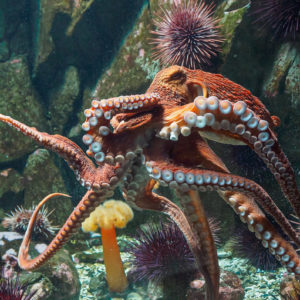Pushed Aside: Northern Gateway Tanker Traffic Would Oust Marine Birds from Feeding Zones
Protests continue against the Northern Gateway project. From economic arguments (here and here), to more grassroots opposition, the groundswell against this project grows.
In earlier posts I summarized the risks marine birds would face from artificial lights and overhead wires. But as more and more tanker traffic invades their traditional marine habitat – more than 200 a year — birds would be forced to make way. And we know from experience that many bird species don’t respond well to such disruption.
Marine bird species vary widely in their sensitivity to boat traffic. Most studies measure this by recording something called flush distance –that’s the distance at which birds leave an area when vessels pass by.
Large flocks of Common Scoters are known to flush at distances between 1,000-2,000 metres, while Marbled Murrelets, Rhinoceros Auklets and Common Murres require a buffer of more than 150 metres to eliminate most instances of disturbance. For the Pelagic Cormorant, it’s more than 200 metres. Researchers have recommended a buffer of 600 metres from shore for Black Guillemots.
Why is this a big deal? Temporarily startling a bird may not seem all that serious, but flushing weakens birds by causing them to waste precious energy, or by preventing them from feeding. It can reduce the amount of fish foraged for feeding chicks. And these distractions would be near constant; huge tankers would pass through the feeding grounds of millions of seabirds about every other day if Gateway is approved.
In assessing the pipeline project’s impact on marine birds, Enbridge referred to several studies on the Marbled Murrelet, a slender-billed, permanent resident of B.C.’s coast.
 |
| Marbled Murrelet: Tom Middleton |
One study reported that most small boats were able to approach within 40 metres before the birds reacted. Similar distances were reported in an Alaskan study that observed Marbled Murrelets in proximity to boats of a range of sizes. A 2008 project studied the closely related Kittlitz’s Murrelet and reported that birds recovered from displacement within a day.
But the issue of displacement of marine birds by vessels is more complex than suggested by simple measures of flush distances and duration. The Alaskan Marbled Murrelet study cited by the proponent to suggest that the species is relatively insensitive to disturbance by boats also found that staging adults that were holding fish (presumably to be delivered to chicks) tended to swallow their fish when boats approached. A lost meal may represent a considerable energetic expense for Marbled Murrelets, which often forage at great distance from their nests.
And within species, not all birds are the same. Juvenile birds flush at greater distances and more frequently than do adults. And birds are likely to leave the feeding areas completely if disturbed by boats late in the breeding season.
The effect of being shunted aside by giant tankers is made worse, depending on which area the birds are forced to vacate. If a bird’s traditional feeding area happens to be in a shipping lane, for example, a bird may not have the chance to adequately fill up before beginning a long migratory journey.
In written evidence submitted to the joint review panel assessing the merits of this pipeline proposal, our experts found Enbridge’s analysis of the potential impacts from vessel traffic to be “too simplistic”, “incomplete” and “inadequate.” (The review of the project’s potential effects on marine birds was written by avian expert Anne Harfenist.)
One reason: Enbridge’s application focused largely on bird sightings far from the actual shipping lanes where displacement would take place.
From Enbridge’s application:
“the majority of Surf Scoter vessel survey observations were recorded in sheltered inlets and bays along Douglas and Principe Channels … The majority of remaining observations were along shoreline areas bordering the proposed approach routes. Surf Scoters remain in intertidal and sub-tidal habitats along shallow, protected bays, fjords and estuaries during foraging; as such they tend to be geographically separated from the majority of Project-related marine transportation.” (emphasis mine)
In other words, Enbridge chose two species that congregated far from the tanker traffic lanes, and then used those findings to argue that all marine species would be insignificantly affected. An adequate assessment would have examined bird species that overlap spatially with vessel traffic; for example, Ancient Murrelet, a species of Special Concern found in more open waters.
Meanwhile, the three-person joint review panel continues to hear from concerned Canadians. If you aren’t attending one of the panel’s public sessions, take your concerns directly to the Prime Minister.
You can also still submit a letter to the Joint Review Panel; the deadline to do so has been extended to August 31, 2012.




